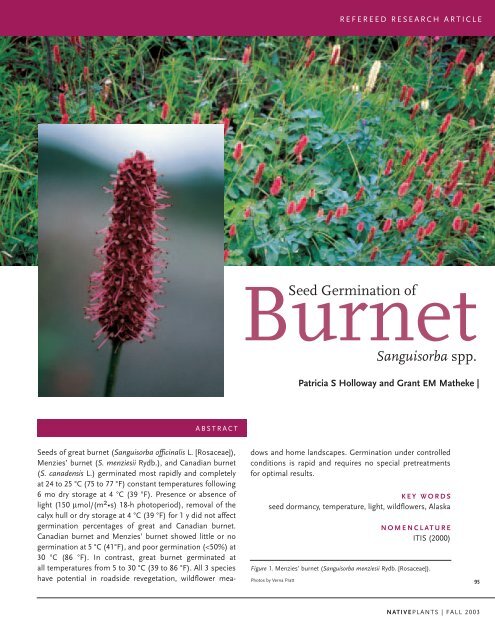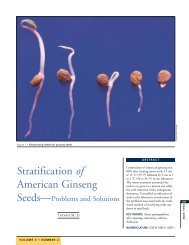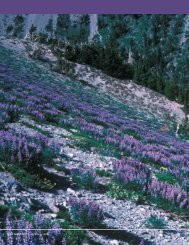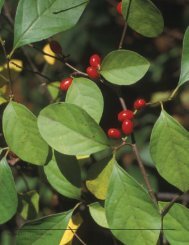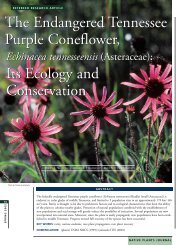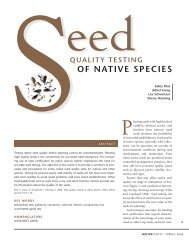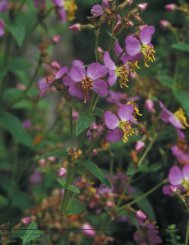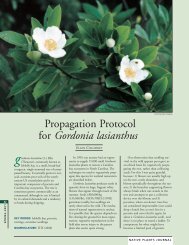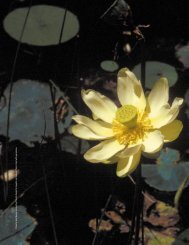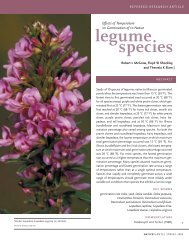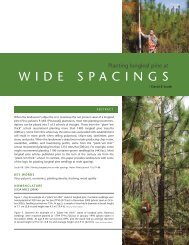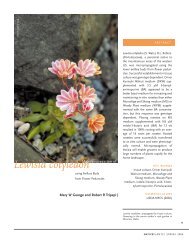16966-INTERIOR layout - Native Plants Journal
16966-INTERIOR layout - Native Plants Journal
16966-INTERIOR layout - Native Plants Journal
You also want an ePaper? Increase the reach of your titles
YUMPU automatically turns print PDFs into web optimized ePapers that Google loves.
REFEREED RESEARCH ARTICLE<br />
Burnet<br />
Seed Germination of<br />
Sanguisorba spp.<br />
Patricia S Holloway and Grant EM Matheke |<br />
ABSTRACT<br />
Seeds of great burnet (Sanguisorba officinalis L. [Rosaceae]),<br />
Menzies’ burnet (S. menziesii Rydb.), and Canadian burnet<br />
(S. canadensis L.) germinated most rapidly and completely<br />
at 24 to 25 °C (75 to 77 °F) constant temperatures following<br />
6 mo dry storage at 4 °C (39 °F). Presence or absence of<br />
light (150 µmol/(m 2 •s) 18-h photoperiod), removal of the<br />
calyx hull or dry storage at 4 °C (39 °F) for 1 y did not affect<br />
germination percentages of great and Canadian burnet.<br />
Canadian burnet and Menzies’ burnet showed little or no<br />
germination at 5 °C (41°F), and poor germination (
96<br />
Three species of wild burnet have potential in northern<br />
landscapes for wildflower meadows, home and commercial<br />
landscapes, and highway revegetation projects: great<br />
burnet (Sanguisorba officinalis L. [Rosaceae]), Menzies’ burnet<br />
(S. menziesii Rydb.), and Canadian burnet (S. canadensis L.).<br />
Menzies’ and Canadian burnet are primarily coastal species in<br />
Alaska, growing in wet meadows and roadside ditches (Figure<br />
1). Menzies’ burnet has the most restricted distribution, occurring<br />
in coastal areas from Alaska to Oregon. Canadian burnet<br />
grows in North America from Alaska to Labrador and south to<br />
Georgia, Indiana, and Illinois. Great burnet is a circumpolar<br />
species and grows throughout Europe and Asia to the Far East<br />
(Hultén 1974). It is known primarily as a medicinal plant in<br />
Europe and Asia (Krylova and Orishchenko 1982; Grieve 1995).<br />
Great burnet is found along the Yukon River drainage in Alaska<br />
and is used occasionally in wildflower seed mixes. All species are<br />
grown in perennial ornamental landscapes.<br />
The 3 species form rosettes of pinnately compound leaves<br />
with tall, willowy scapes topped with maroon or white, thimble-shaped,<br />
dense flower spikes (Figure 1). Achenes persist in<br />
dense spikes until late autumn when they shatter, scattering<br />
most seeds within a 1 m 2 (11 ft 2 ) area around the plant. When<br />
harvested, a dry, papery calyx hull that cannot be removed<br />
with air-screen seed cleaners often surrounds achenes.<br />
All species can be propagated by seeds and division, but germination<br />
requirements for controlled environment propagation<br />
and commercial production are unclear. MaGuire and<br />
Overland (1972) reported 28% germination of great burnet at<br />
alternating 20 to 30 °C (68 to 86 °F) temperatures. Rutledge<br />
(1995) field-seeded great burnet as part of a wildflower seed<br />
mix in Fairbanks, Alaska. Germination occurred in spring after<br />
fall sowing, but seeds sown in spring without an overwintering<br />
period did not germinate. Under controlled conditions (constant<br />
21 °C (70 °F), 18-h photoperiod), the same seed lot without<br />
chilling treatment had 60% germination. In a preliminary<br />
unpublished investigation, we found that 1 wk to 5 mo of cold<br />
stratification at 4 °C (39 °F) followed by a temperature of 21 °C<br />
(70 °F) in light did not improve germination compared to seeds<br />
without the chilling. Serigstad (1998) found that light was necessary<br />
for germination of great burnet seeds.<br />
Baldwin (1997) reported poor (8%) germination of<br />
Menzies’ burnet seeds 30 d after harvest, whereas seeds stored<br />
in a cool, dry place for 120 d had 82% germination. The popular<br />
gardening literature presents a picture of burnet species<br />
that germinate readily without an after-ripening treatment<br />
(LH Bailey Hortorium 1976; Grieve 1995; Huxley and others<br />
1999). These few limited experiments hint that germination<br />
might require or be enhanced by a chilling treatment, light, or<br />
possibly a dry storage treatment. Our project explored seed<br />
germination of these species in relation to light, temperature,<br />
storage time, and calyx hull removal in order to determine<br />
optimum germination conditions for cultivation.<br />
METHODS AND MATERIALS<br />
Wild-harvested seeds of Canadian and Menzies’ burnet were obtained<br />
from a commercial seed source in Kenai, Alaska. We hand<br />
harvested great burnet seeds from plants grown under cultivation<br />
in Fairbanks, Alaska. All seeds were cleaned and stored at<br />
4 °C (39 °F) for 6 mo except for the experiment comparing<br />
freshly harvested seeds with those stored as above for 1 y. Prior to<br />
germination, seeds were floated in water to remove non-filled<br />
seeds. We conducted all germination tests in growth chambers at<br />
constant temperatures with a light level of 150 µmol/(m 2 •s) photosynthetic<br />
photon flux at the surface of the bags for an 18-h<br />
photoperiod. Experiments consisted of 4 replicates of 100 seeds<br />
for each treatment arranged in a completely randomized design.<br />
All seeds were sown on filter paper moistened with autoclaved<br />
distilled water in glass petri dishes that were enclosed in clear<br />
plastic bags to reduce evaporation. We defined successful germination<br />
as radicle emergence from the seed coat.<br />
Experiment 1 – Optimum Temperature<br />
Our treatments consisted of 6 constant temperatures ranging<br />
from 5 to 30 °C (41 to 86 °F) at 5 + 1 °C increments. The<br />
6 temperatures were supplied by separate growth chambers<br />
running concurrently, and we counted the number of germinants<br />
daily for 30 d.<br />
Experiment 2 – Light Effects<br />
We compared 4 dishes of seeds individually wrapped in<br />
aluminum foil to exclude light with 4 dishes receiving the<br />
same light levels and duration described above. The growth<br />
chamber was a constant 20 °C (68 °F). Germination was<br />
counted once after 21 d for both treatments.<br />
Experiment 3 – Fresh Versus Stored Seeds<br />
We sowed 4 dishes each of great burnet and Canadian burnet<br />
with freshly harvested and cleaned seeds. Dishes were placed<br />
in a growth chamber set at 20 °C (68 °F). An additional 4 dishes<br />
of each species were sown with cleaned seeds, enclosed in<br />
plastic bags, and stored dry and in complete darkness at 4 °C<br />
(39 °F) for 1 y. An identical germination test to the freshly harvested<br />
seeds was performed following the storage period.<br />
Experiment 4 – Calyx Removal<br />
We removed papery calyx hulls from 400 seeds each of<br />
great burnet and Canadian burnet by gently rubbing them<br />
against an aluminum screen. Because hulls separated easily<br />
from seeds, this process required about 15 s of mechanical<br />
abrasion. Although no visible change occurred to the seed covering,<br />
we defined this treatment as hull removal and possible<br />
mechanical scarification. Germination temperatures were a<br />
constant 20 °C (68 °F), and we examined the seeds daily for 30<br />
d for successful germination.<br />
NATIVEPLANTS | FALL 2003<br />
SEED GERMINATION OF BURNET
STATISTICAL ANALYSIS<br />
Following all experiments, nongerminated seeds were examined<br />
for empty seeds, of which none were found, and no additional<br />
adjustments were made to final germination percentages<br />
prior to statistical analysis. Data for Experiment 1 were subject<br />
to regression analysis on arcsine transformed data using Proc<br />
GLM in SAS (SAS Institute Inc 1997) to identify optimum germination<br />
temperature. Data for Experiments 2, 3, and 4 were<br />
analyzed on arcsine-transformed data using ANOVA for completely<br />
randomized design (SAS Institute Inc 1997).<br />
RESULTS<br />
Experiment 1 – Optimum Temperature<br />
Germination for all burnet species was most rapid at 25 °C<br />
(77 °F),beginning 5 d after initiation for great and Menzies’burnet<br />
and 4 d for Canadian burnet (Figure 2).The most complete germination<br />
occurred within 15 d at 25 °C (77 °F) for great and Menzies’<br />
burnet. Both achieved 50% of total germination (T-50) after 7 d<br />
and 6 d, respectively. Complete germination of Canadian burnet<br />
was accomplished with 50% of the seeds germinating in 9 d.<br />
In all species, the total germination and speed of germination<br />
decreased with temperatures above and below the optimum.<br />
Canadian burnet did not germinate at 5 °C (41°F) and Menzies’<br />
burnet reached 4% germination at this temperature only at termination<br />
of the experiment. Germination of great burnet was delayed<br />
5 d at 5 °C (41 °F) and amounted to less than half the total germination<br />
at the optimum 25 °C (77 °F).All species showed reduced<br />
germination at 30 °C (86 °F) when compared to the optimum.<br />
Curvilinear regression of the total germination percentage<br />
across all temperatures generated highly significant third<br />
order polynomial models for each species (Table 1). The predicted<br />
optimum germination temperature based on these<br />
models was nearly the same for all species.<br />
Experiments 2, 3, and 4<br />
Seeds of all species germinated as well in light and dark<br />
(Table 2). Germination percentages of freshly harvested seeds<br />
of great and Canadian burnet seeds were statistically similar<br />
when compared to seeds stored for 1 y at 4 °C (39 °F). Seeds<br />
with and without a papery calyx hull germinated equally well.<br />
Figure 2. Cumulative germination percent of great, Canadian, and Menzies’<br />
burnet seeds germinated at 6 constant temperatures between 5 °C (41 °F)<br />
and 30 °C (86 °F).<br />
DISCUSSION AND CONCLUSIONS<br />
All burnet species showed similar germination requirements<br />
and optimum germination temperatures. Great burnet<br />
showed greater adaptation to extreme temperature conditions<br />
by germinating better than Menzies’ and Canadian burnet at<br />
30 °C (86 °F). Great burnet also germinated better than the<br />
97<br />
PATRICIA S HOLLOWAY AND GRANT EM MATHEKE NATIVEPLANTS | FALL 2003
TABLE 1<br />
Predicted optimum germination temperature for 3 burnet species.<br />
Species Curve-fit model R 2 Predicted optimum<br />
germination temperature<br />
°C (°F)<br />
Great burnet y = 72.767 – 13.496x + 1.1171x 2 – 2.2481e-2x 3 0.983 25 (77)<br />
Menzies’ burnet y = 15.333 – 5.0585x + 0.70817x 2 – 1.7741e-2x 3 0.971 24 (75)<br />
Canadian burnet y = 32.162 – 10.653x + 1.0675x 2 – 2.3188e-2x 3 0.936 25 (77)<br />
TABLE 2<br />
Germination of burnet (Sanguisorba spp.) under light exclusion, warm dry storage, and removal of calyx hulls.<br />
Treatment<br />
Total germination (%) by species<br />
Great burnet Canadian burnet Menzies’ burnet<br />
Light 71 + 8 72 + 5 55 + 5<br />
Dark 69 + 5 75 + 6 45 + 8<br />
Fresh seeds 79 + 4 56 + 6<br />
Storage for 1 y 75 + 6 50 + 8<br />
With calyx hulls 72 + 5 59 + 7<br />
Calyx hulls removed 76 + 8 61 + 6<br />
Means within treatment groups and species did not differ significatly for all experiments, P ≤ 0.05.<br />
98<br />
other species at cold temperatures indicating a significant<br />
advantage in Alaska’s many cold, wet soils, and may help<br />
explain this plant’s broader geographic range.<br />
The prompt and complete germination of great burnet<br />
surprised us. In a previous study on establishment of wildflower<br />
mixes on irrigated sites (Rutledge 1995), great burnet<br />
seeds failed to germinate the first year but did germinate the<br />
following year. This suggests an ecodormancy, but spring field<br />
soil temperatures the first year were well within the germinable<br />
range of this species. Our subsequent, unpublished<br />
laboratory experiments with great burnet seeds treated with<br />
up to 5 mo cold stratification showed no improvement in germination<br />
percentages over untreated seeds. Other environmental<br />
factors such as alternating temperatures, soil moisture,<br />
or pH, may influence germination in cultivated fields.<br />
Seeds of all species showed no response to light or dark<br />
treatments which was contrary to previous research by<br />
Serigstad (1998) who found light was necessary for germination<br />
of Canadian burnet. Because phytodormancies often disappear<br />
with time, the discrepancy may involve differences in<br />
seed age between experiments, although this information was<br />
not available from Serigstad’s report. Seed pretreatments,<br />
such as calyx hull removal or cool dry storage for 1 y, do not<br />
enhance germination of great and Canadian burnet.<br />
PRACTICAL IMPLICATIONS<br />
Our experiments support the general horticulture literature<br />
that burnet species germinate easily with no special pretreatments<br />
(LH Bailey Hortorium 1976; Grieve 1995; Huxley and<br />
others 1999). Our recommendation for optimum germination<br />
of great, Canadian, and Menzies’ burnet seeds under controlled<br />
conditions include using cleaned seeds with or without<br />
an attached calyx hull, followed by germination at 24 to 25 °C<br />
(75 to 77 °F) in light or darkness. Radicle emergence begins<br />
within 4 to 5 d and is nearly complete within 30 d. Great burnet<br />
and Menzies’ burnet show rapid germination within the<br />
first 2 wk, while Canadian burnet germination is more gradual,<br />
extending at least to 30 d.<br />
NATIVEPLANTS | FALL 2003<br />
SEED GERMINATION OF BURNET
ACKNOWLEDGMENT<br />
We thank Mr Richard Baldwin of Seeds for Alaska, Kenai,<br />
Alaska for donating seeds for this study.<br />
REFERENCES<br />
Baldwin RL. 1997. Growing Alaska natives. The propagation of Alaska’s<br />
native plants. Kenai (AK): Seeds of Alaska. 105 p.<br />
Grieve M. 1995. Great burnet and Canadian burnet. URL: http://www.<br />
botanical.com/botanical/mgmh/b/burgre88.html (accessed 12 Jun 2000).<br />
Hultén E. 1974. Flora of Alaska and neighboring territories. Stanford (CA):<br />
Stanford University Press. 1008 p.<br />
Huxley A, Griffiths M, Levy M, editor. 1999. The Royal Horticultural Society<br />
dictionary of gardening. Volume 4. New York (NY): Groves Dictionaries<br />
Inc. 888 p.<br />
[ITIS] Integrated Taxonomic Information System. 2000. Biological names.<br />
Version 4.0. URL: http://www.itis.usda.gov (accessed 10 Sep 2000).<br />
Krylova IL, Orishchenko ND. 1982. Variability in garden burnet<br />
(Sanguisorba officinalis L.) in natural populations in west Siberia and the<br />
Altai and during cultivation. Soviet <strong>Journal</strong> of Ecology 13(5):311–317.<br />
LH Bailey Hortorium. 1976. Hortus III. New York (NY): Macmillan<br />
Publishing Co Inc. 1290 p.<br />
MaGuire JD, Overland A. 1972. Laboratory germination of seeds of weedy<br />
and native plants. Pullman (WA): Washington State University<br />
Agricultural Experiment Station. Circular 349. 13 p.<br />
Rutledge O. 1995. Evaluation of wildflower seed mixes for Interior Alaska<br />
[MSc thesis]. Fairbanks (AK): University of Alaska Fairbanks. 95 p.<br />
SAS Institute Inc. 1997. SAS/STAT general linear model. Release 8.10<br />
Edition. Cary (NC): SAS Institute Inc.<br />
Serigstad A. 1998. Spiremetoder for stauder metode database. (on-line database).<br />
URL: http://www.asles.net/sodata.htm (accessed 10 Sep 2001).<br />
AUTHOR INFORMATION<br />
Patricia S Holloway<br />
Associate Professor of Horticulture<br />
ffpsh@uaf.edu<br />
Grant EM Matheke<br />
Superintendent<br />
fngem@uaf.edu<br />
Georgeson Botanical Garden<br />
Department of Plant, Animal and Soil Sciences<br />
PO Box 757200<br />
University of Alaska Fairbanks<br />
Fairbanks, AK 99775<br />
99<br />
PATRICIA S HOLLOWAY AND GRANT EM MATHEKE NATIVEPLANTS | FALL 2003


